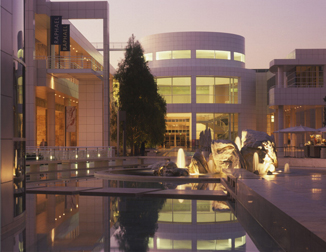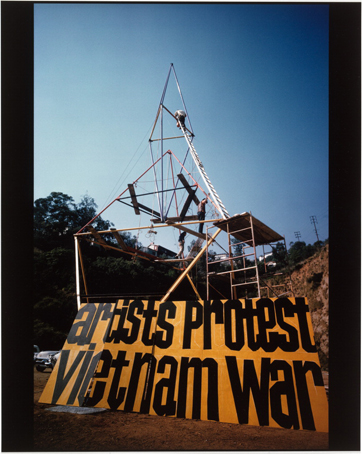
Artist Peace Tower installation (1966)
Charles Brittin
Peace Tower (also known as the Artists' Tower of Protest) was the first major artist-organized protest against the Vietnam War anywhere in the United States. It mobilized artists from across Southern California, and it also featured work by artists from around the world; it became a model for future instances of artistic activism. In 1971 Brittin's photograph was featured on the cover of Art in America to accompany an essay on the "Politicization of the Avant-Garde." In 2006 the Tower was re-created by Rirkrit Tiravanija at the Whitney Museum of American Art.
Silver dye bleach print 19 15/16 x 15 15/16 in
Charles Brittin Papers, The Getty Research Institute, Los Angeles (2005.M.11.37) © J. Paul Getty Trust
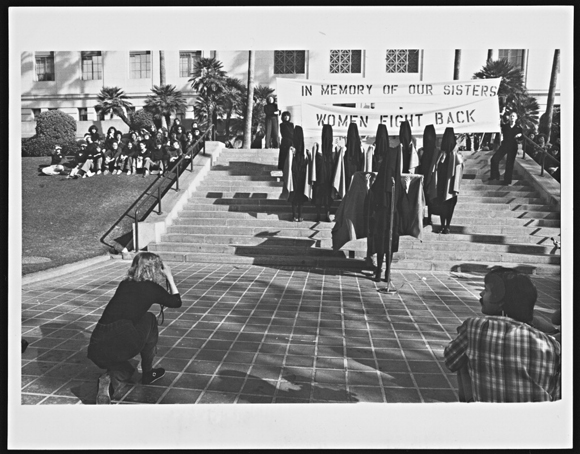
In Mourning and In Rage (December 13, 1977)
Leslie Labowitz-Starus
In Mourning and In Rage, by Suzanne Lacy and Leslie Labowitz-Starus, is one of the iconic pieces to emerge from the Feminist Art movement in the 1970s. An action that took place on the steps of City Hall, it shows how the artists were engaging with larger social concerns through art, and the way public performance could make people aware of these. Certainly to judge from the press attendance, the performance managed to attract much coverage of the issues.
Gelatin silver print 7 15/16 x 10 3/16 in
The Getty Research Institute, Los Angeles (2003.M.46) Photograph by Susan Mogul
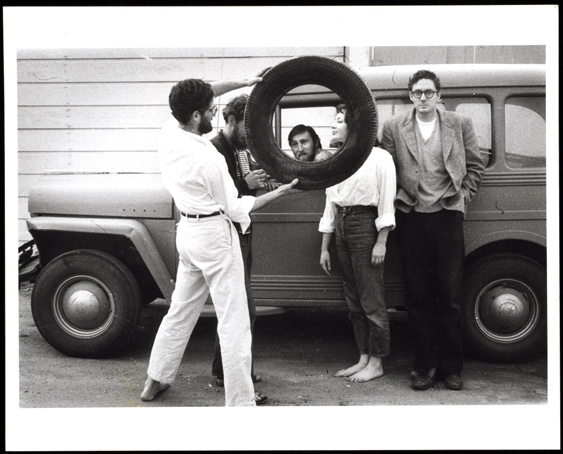
Ferus Alley (ca. 1957)
Charles Brittin
This photograph was taken around the time of Wallace Berman's exhibition at the Ferus Gallery, which was subsequently shut down following Berman's arrest on obscenity charge. It depicts the close, informal, and often playful relationship between artists and Hopps.
Gelatin silver print 8 x 10 in
The Getty Research Institute, Los Angeles (2005.M.11) © J. Paul Getty Trust
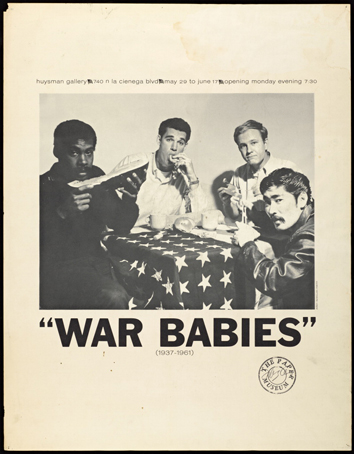
Poster for the Exhibition War Babies (1961)
Jerry McMillan
In 1960 the young Henry Hopkins opened the Huysman Gallery in Los Angeles; the following year he agreed to a show of four young artists: Joe Goode, Larry Bell, Ron Miyashiro, and Ed Bereal. The exhibition poster designed by Goode drew the ire of both the Left (for its playing with stereotypical ethnic depictions) and the Right (for its use of the American flag as a tablecloth). Members of the John Birch Society wrote and telephoned the gallery to express their outrage, and the controversy contributed to the gallery's demise. The episode demonstrates the young artists' willingness to push buttons, as well as the public's willingness to push back.
Offset lithograph 21 7/8 x 17 1/16 in
The Getty Research Institute, Los Angeles (2006.M.1.5) © Joe Goode. Courtesy Jerry McMillan and Craig Krull Gallery, Santa Monica

Event Performance by Wolfgang Stoerchle (1970)
Wolfgang Stoerchle
The photograph records Wolfgang Stoerchle's performance, simply called Event, which served as his MFA exhibition at the University of California, Santa Barbara, and which was broadcast on the local NBC station. The performance consisted of Stoerchle and a gymnast athletically colliding with blocks of plaster. It is a vivid example of the kind of creative experimentation—and especially bodily-based performance art—which took root in the fertile art school scene across Southern California.
Gelatin silver print 9 15/16 in
Wolfgang Stoerchle Papers, The Getty Research Institute, Los Angeles (2009.M.16.1) © J. Paul Getty Trust
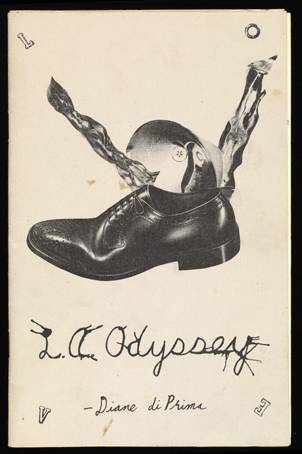
L.A. Odyssey (July 28-August 5, 1969)
George Herms
George Herms designed the cover for L.A. Odyssey, a book of poems by Diane di Prima. A late example of the presence of the Beat movement in Southern California, it also demonstrates the centrality of hand printing and collage as modes for artistic experiment by artists in the Beat circle.
8 5/8 x 5 9/16 x 1/16 in
The Getty Research Institute, Los Angeles (2009.M.20.27) © J. Paul Getty Trust
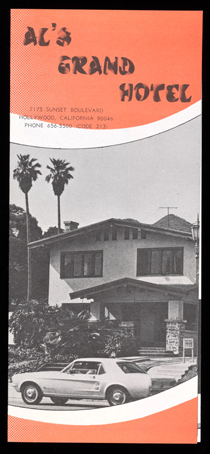
Al's Grand Hotel Mailing (May 2, 1971)
Allen Ruppersberg
The young Al Ruppersberg created and ran his variation of the Grand Hotel at 7175 Sunset Blvd. for six weeks beginning in May 1971. It featured seven specially designed theme rooms that were available for $15 to $30 a night, continental breakfast included. All of the props used in the piece were for sale as souvenirs. The project ran concurrently to the Art and Technology exhibition at LACMA, and demonstrates the willingness of conceptually oriented artists to blur the lines between art and everyday life, high and mass culture.
Offset lithograph brochure 9 1/16 x 4 1/16 in
The Getty Research Institute, Los Angeles (2009.M.30.2) © Allen Ruppersberg
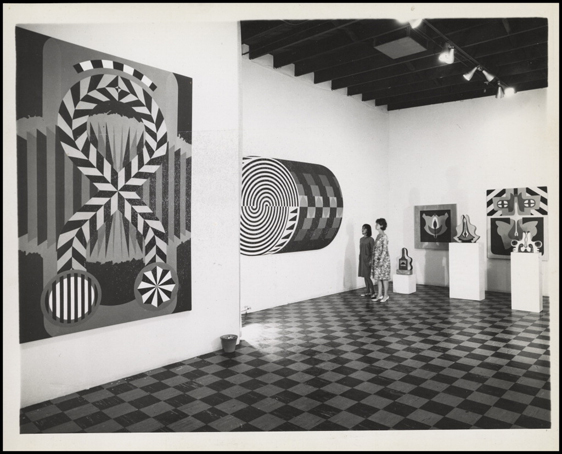
Rolf Nelson Gallery Interior (May 1964)
Unknown Artist
The photograph shows two visitors to a group show of abstract paintings by, among others, Judy Gerowitz (who changed her name to Judy Chicago). Rolf Nelson, at whose gallery this photo was taken, was at the time one of the leading dealers for avant-garde art working in Los Angeles. He gave important early exposure to local artists such as Llyn Foulkes, Joe Goode, George Herms, and Lloyd Hamrol, as well as older artists, such as Georgia O'Keeffe. This photograph, taken in Nelson's first location, gives a feel of what his gallery—and the period in general—was like.
Gelatin silver print 8 1/16 x 9 15/16 in
The Getty Research Institute, Los Angeles (2010.M.38.2) Courtesy of Rolf Nelson

Womanhouse Catalog (1972)
Sheila Levrant de Bretteville
The cover of the Womanhouse catalog shows Judy Chicago and Miriam Schapiro, the directors of the Feminist Art Program that had just begun at CalArts. They are sitting on the steps of the house on Mariposa Avenue in Hollywood that was renovated and used by the students enrolled in the program. Womanhouse featured over twenty installations by students, which interpreted the dreams and fantasies of women in the domestic space; in addition, Womanhouse hosted performances. One of the earliest examples of the importance of feminism in artistic practice anywhere, it still stands as a symbol of the Feminist Art movement in Southern California.
8 7/16 x 8 1/2 in
Getty Research Institute, Los Angeles (89-B23677) Courtesy of CalArts Archives


